CENTENARY 1924-2024 1
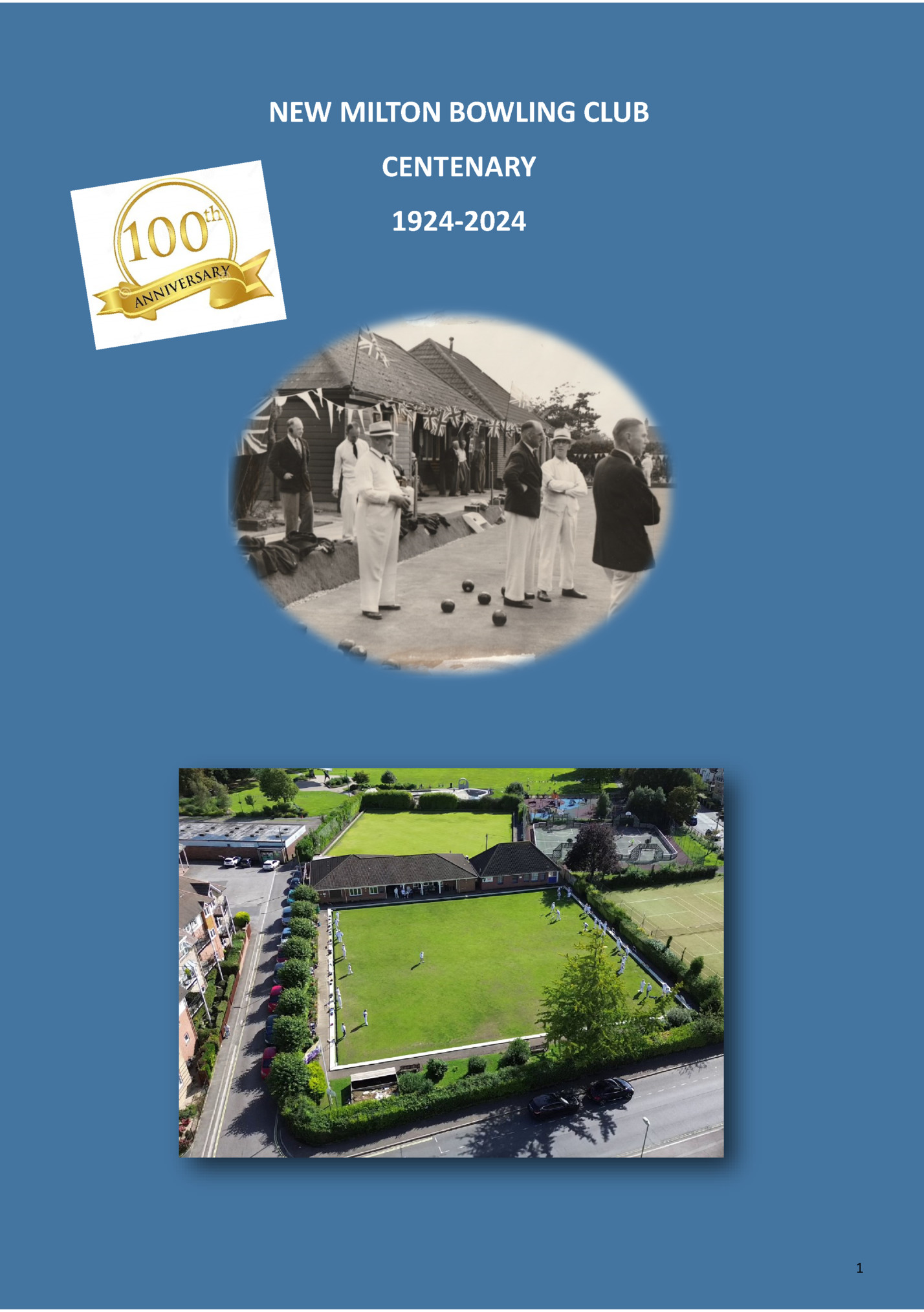
I am honoured to have been elected as the Club President for 2024, our Centenary Year. We look forward to celebra ng everything that has been admirable and successful about New Milton Bowling Club over the last 100 years. From the founding of the Club in 1924 on the Recrea on Ground site, members have combined and worked relessly to create the successful Club we enjoy today. Through a mixture of sound administra on, forward planning, community involvement and fundraising this Club has contributed so much to the local area. We look forward to welcoming all visitors, past members, all our present members and guests to the 2024 season of celebra on matches and events. SPECIAL CENTENARY EVENTS « 3rd July - BOWLS ENGLAND DAY « ¨ 24th July - New Forest Gala Day ¨ 14th August - Bournemouth & District Gala Day ¨ 15th September - A Special President’s Members’ Day …...and a number of Open Days Precise details will be found on the club website 2
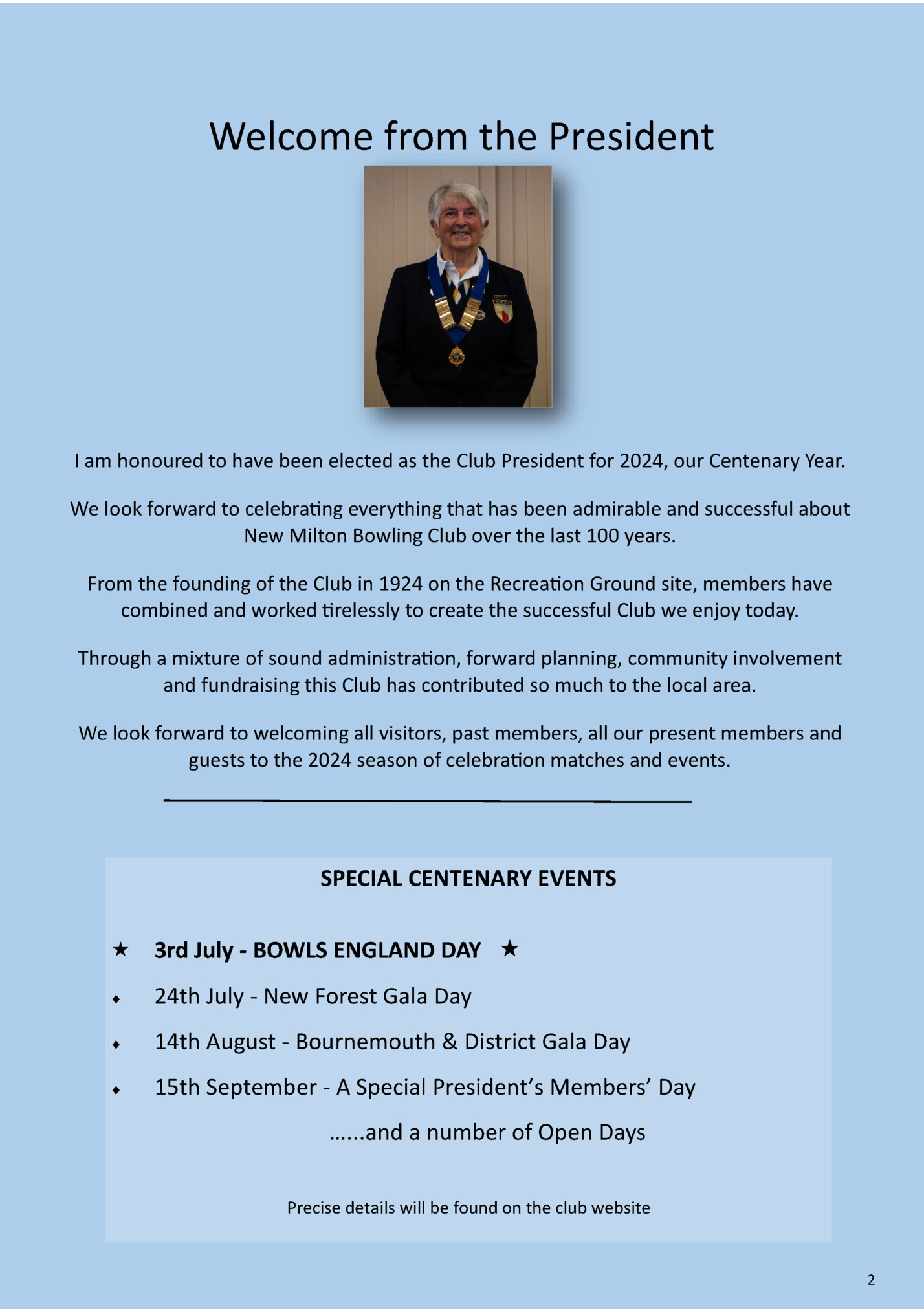
Alan Taylor Trish Towner Eric Milsom Bill Wallace Kim Levi Phil Brockhurst John Towner Maureen Clark Kevin Holland Tony Prince SOCIAL TEAM John Towner Trish Towner Karen Milsom Eric Milsom GREENS & BUILDINGS TEAM Alan Taylor Richard Silcock John Towner Mar n Smith Steve Burfield LADIES’ COMMITTEE Pat Akerman Mary Herlihy Maureen Clark Kim Levi Wendy Baylis Karen Winter 3
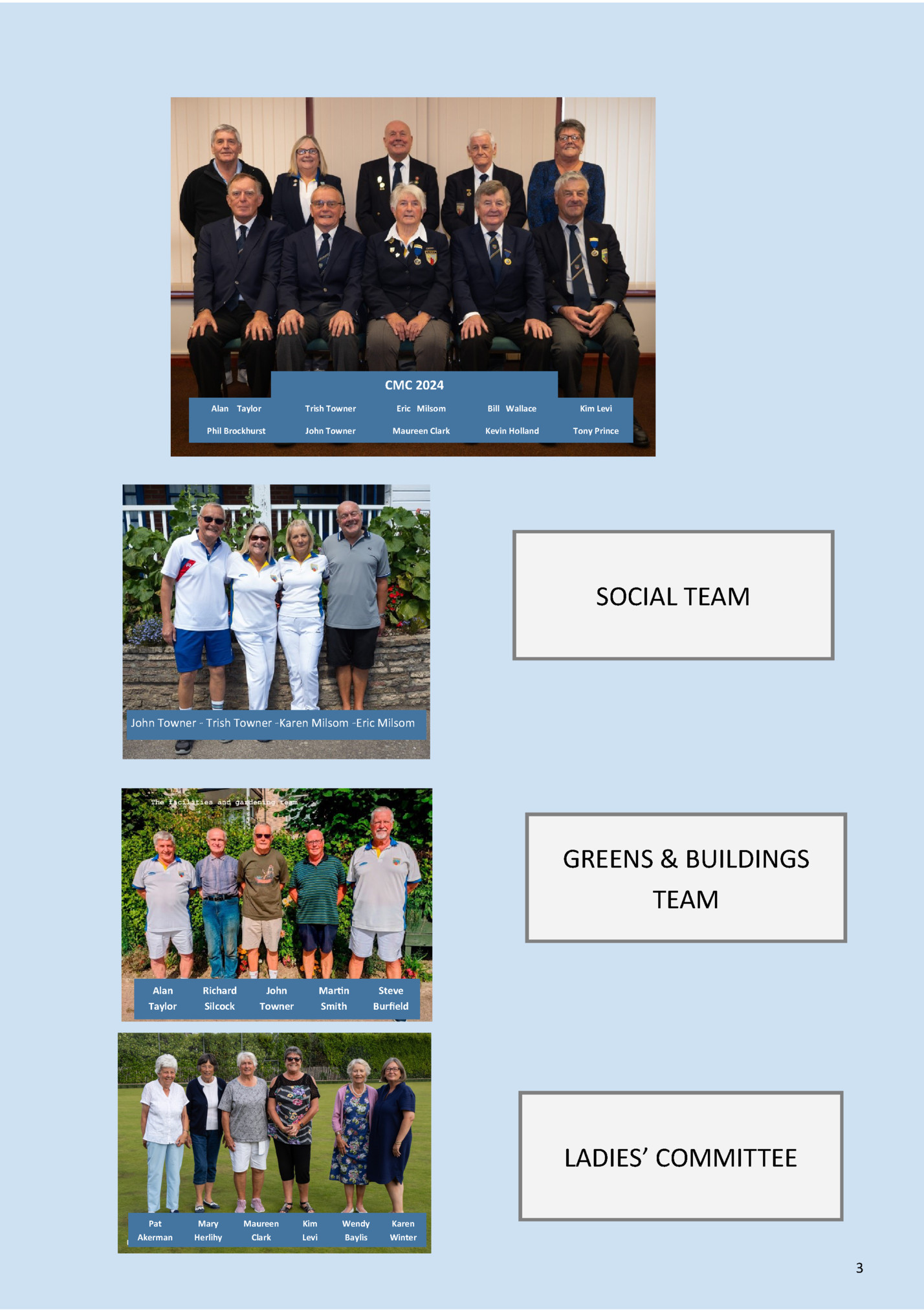
Introduc on The history of the New Milton Bowling club is also a part of the history of Milton Parish. In 2024 the club celebrates its centenary. How the club came into being and how it has gone from strength to strength for one hundred years through economic turmoil and a World War is worthy of note. This short history of the club will review what the land was originally used for, how it came into being and who the local residents were who created the club from scratch, with such a superb green and clubhouse. The Land The land currently used by New Milton Bowling Club was once part of the Fernhill Manor estate and is men oned in the Domesday book. Eventually it came into the possession of John Fromond who on his death in 1420 bequeathed it to Winchester College. He was a steward of the college and looked a er their many estates and possessions. The area was farmland, known as Whitefield Farm on the 1841 Tithe Map. The farm covered an area which, today is roughly from south of the railway line, north of Old Milton Road, west of Sta on Road and east of Vincent Road. The field on which the bowling club is located was called ‘Garden Plot.’ The farm house and associated buildings were at the corner of what is now Old Milton Road and Sta on Road. The farm land was put up for auc on on July 24th 1914 by Winchester College along with other valuable pieces of land and houses. At the auc on William Hayward the tenant successfully bid for his farm house and a sizable piece of the farm land. The north end of the farm had been used for the building of the railway line and the construc on of part of what is now Whitefield Road. At this me there was rapid growth and development in the area, crea ng a new town brought about by the arrival of the railway in 1886. That town was named ‘New Milton’ in 1896. World War One had a devastating impact on the people of Milton Parish as it did for the rest of the country and abroad. There were 83 men of Milton Parish who lost their lives in the war. In a close-knit, rural, largely farming community these men were mourned not only by their families but by those they went to school with, by sports team mates and work colleagues. There was a collec ve wish of the people of Milton to remember these men. 4
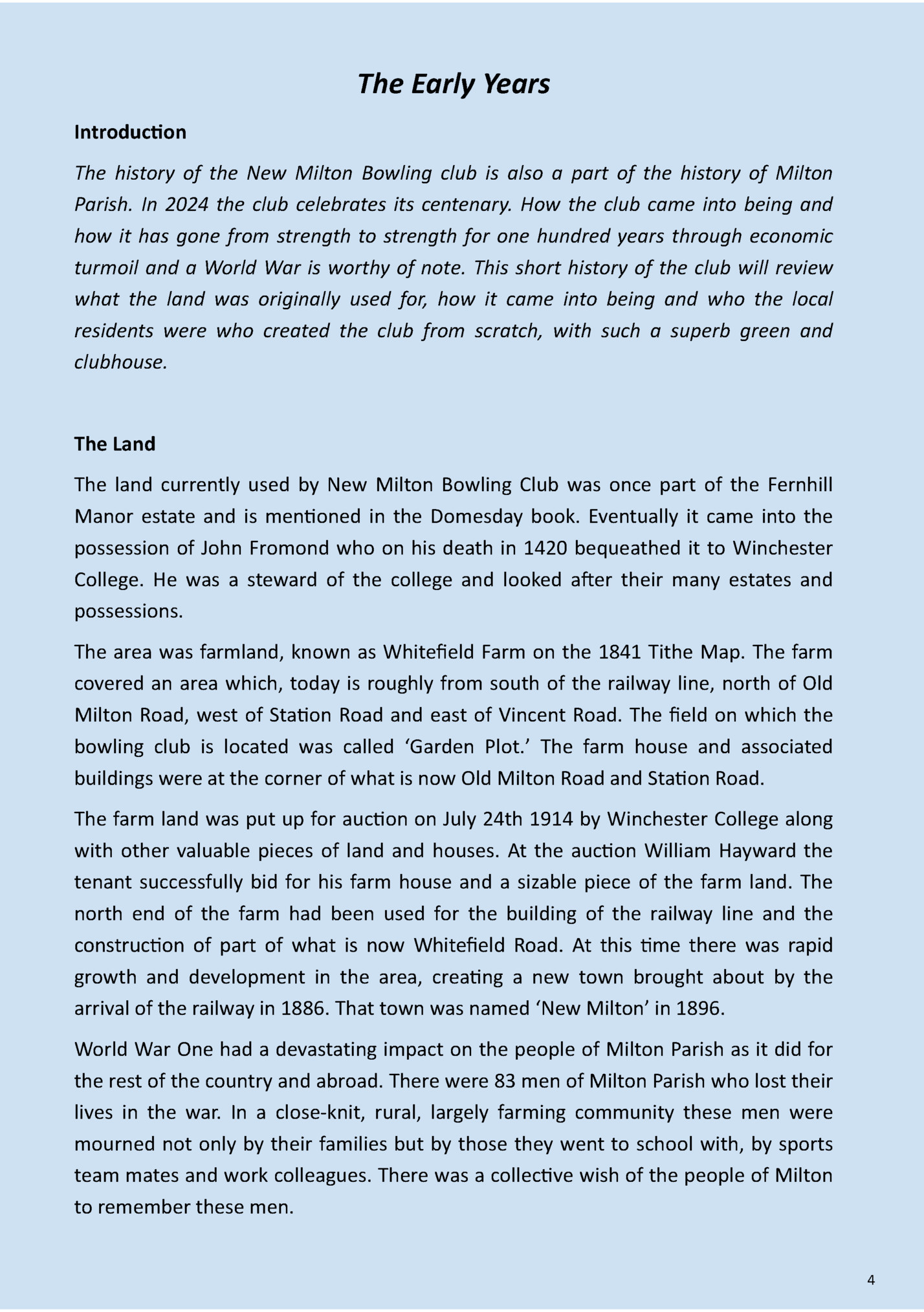
13th May 1924. According to the minutes of the meeting, Mr Edward Vigar was elected to be the first president. The secretary was Mr H.A. Bellamy and the treasurer was Mr F. Ward, who was also the manager of Lloyds Bank. The committee was then elected. They were Major Trestrail, J.B. Stevenson, W. Bowers, A.W. Harley, G. Wesley, A.C. Oliver, J.K. Matterson, A. Hayter and A. Willcocks. It was announced at the meeting that some 65 people had signed up as poten al members of the new club. Mr Stevenson who had some experience in this ma er, was asked for an es mate of how much it would cost of laying the green, he stated it would be about £700. A er the public had departed, a short commi ee mee ng was held where it was agreed that a group of the commi ee members would approach the trustees of the Recrea on Ground to ask if it was possible to use the rough ground between the tennis courts and Whitefield Road as a bowling green. All agreed that the piece of land between the tennis courts and Whitefield Road was an ideal loca on. The commi ee mee ng of the 26th May 1924, was told that it was not straigh orward for the trustees of the Recrea on Ground to sub-let a por on of the field to the bowling club. It was decided that it would be sensible to look around for other sites to locate the green. A subcommi ee was created to inves gate this. The subcommi ee reported back on September 17th sta ng that they had inspected four pieces of ground and had offers from the owners to sell to the bowling club at prices ranging from £240 to £500. The la er was deemed to be the most suitable and the subcommi ee were instructed to ask the owner, Mr Cowan, for the lowest price he would sell for. The commi ee noted that they required funds not just for the ground, but also for the erec on of a substan al wooden pavilion. It was decided to form a limited company called ‘New Milton Bowling Club Ltd.’ With shares being sold at £1 each. At the following commi ee mee ng it was reported that Mr Cowan had offered to sell his land for £450 and fi y shares in the company when it was floated. This offer was open for fourteen days. By October 13th the commi ee had raised £216; Mr Cowan agreed to extend his offer to the end of the month. Mr Matterson wrote to the committee offering to take ten shares. However, if the committee were to come to an agreement with the Recreation Ground trustees on a rental or lease of the undeveloped land at the north east corner, he would offer £200 in support. The subcommittee met the Recreation Ground trustees again and terms were agreed to lease the ground for twenty-one years. In addition to Mr Matterson’s generous offer there was also a bequest from the late Reverend J.E. Kelsall and other offers of financial support. 5
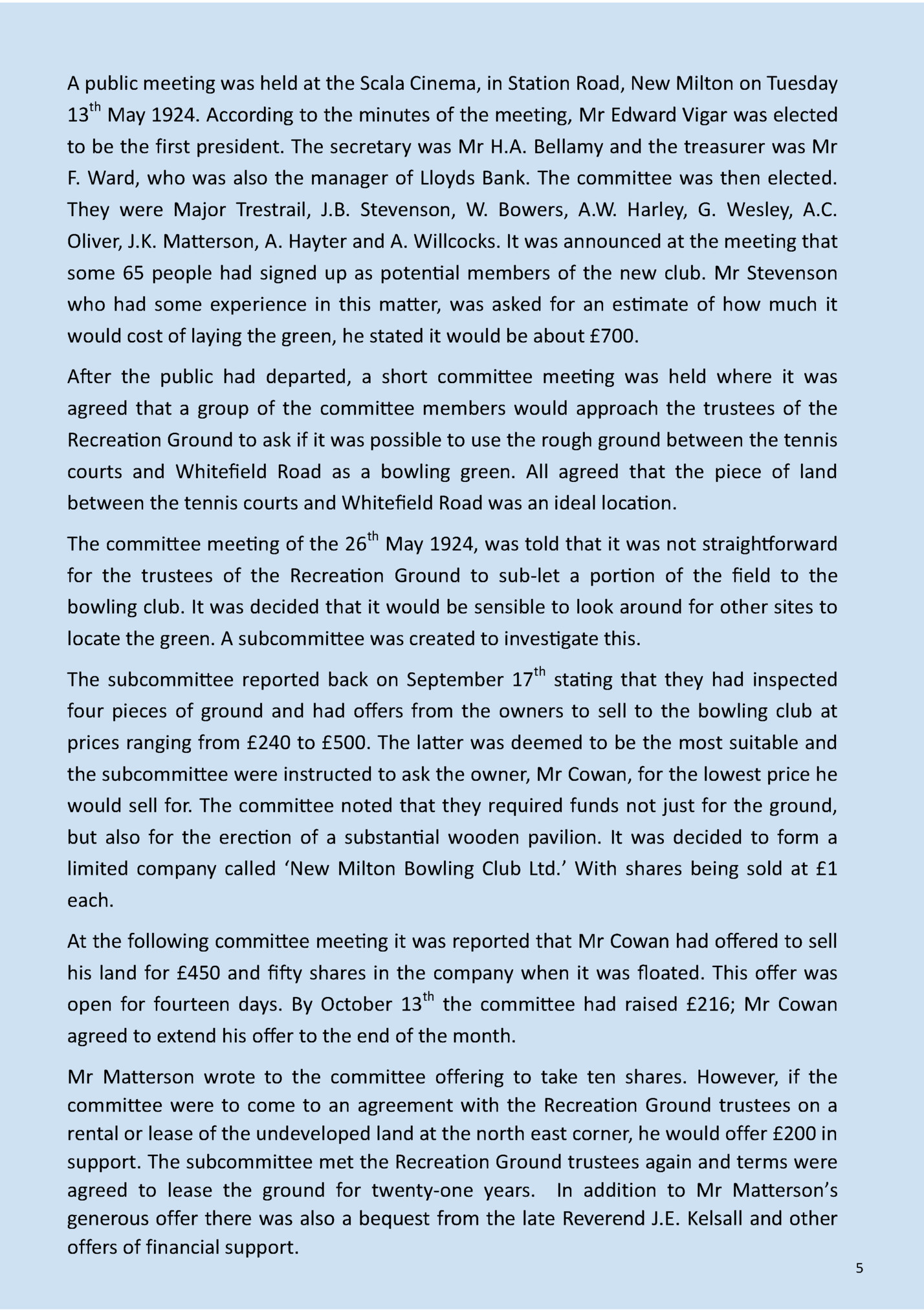
commemorate the names of the Miltonians who had been lost in the war. He started a public collec on to buy a plot of land and erect a war memorial in honour of the Milton fallen. £850 was raised by public subscrip on. William Hayward had, through ill health, given up farming by the end of WW1 and had sold his land to a Mr John Ma erson, a wealthy local pharmacist living in Fernhill Lane. He was extremely suppor ve of the idea of crea ng a war memorial and a public recrea on area for the people of Milton Parish and he agreed to sell the land to the project commi ee of which he was the chairman! The Recrea on Ground and war memorial were unveiled on the 26th September 1920. Reverend Kelsall announced that the ground had been given to the town, debt free, “to be used henceforth for the good of the whole parish.” He went on to say that he did not apologise for naming the field a ‘Recrea on Ground’ since he wanted to see people “recreated” by sport. Football, rugby, and cricket were played on the Recrea on’ Ground although some residents felt there was a need for other forms of sport in the town. Recreation Ground - looking north - 1920s Crea on of the Bowling Club In 1924 two local businessmen, George Wesley and William Bowers, asked the trustees of the Recrea on Ground if a bowling club could be set up. The trustees did not respond favourably. Undeterred, Wesley and Bowers canvassed the local community and had posi ve replies from about 60 or 70 residents. 6

1924 when officers and a committee were elected, with Mr Edward Vigar being the first President. There were 65 potential members of the new club and the rough land between the tennis courts and Whitefield Road was identified as an ideal location. The commi ee noted they required funds, not just for the ground, but also for the erec on of a substan al wooden pavilion. It was decided to form a limited company called ‘New Milton Bowling Co. Ltd’ with shares being sold at £1 each. Mr Ma erson wrote to the commi ee offering to take ten shares. However, if the commi ee were to come to an agreement with the Recrea on Ground trustees on a rental or lease of the undeveloped land at the north east corner, he would offer £200 in support. The subcommi ee met the Recrea on Ground trustees again and terms were agreed to lease the ground for twenty-one years. In addi on to Mr Ma erson’s generous offer there was also a bequest from the late Reverend J.E. Kelsall and other offers of financial support. The minutes of the 10th of November record that the club would be named ‘The Milton and District Bowling Club’ but this seems to have gradually changed to New Milton Bowling Club by 1929. Subsequent commi ee mee ngs discussed the crea on and laying of the bowling green. Acquiring good turf proved to be a challenge. High quality but expensive turf was inspected in Winchester and a local builder, Mr Herbert Drew, offered the club all the turf they required, free of charge provided the club was constructed on the Recrea on Ground site. This was accepted, but on closer examina on the turf was found to be unsuitable. A further offer of turf from Mr Musgrave of the Grand Marine Hotel in Barton on Sea was accepted. Through a misunderstanding when marking out and removing the grass, the turf was eventually supplied by a Mr Baker of Barton on Sea and the laying was completed by the 4th May 1925. Other considera ons included nego a ng with the local water company to connect the bowling green area to the mains water. A fence and shrubs around the green was also required. A small hut was required on the site for the storage of equipment. These ma ers were swi ly completed. On the 16th February 1926 at a public mee ng, again held in the Scala cinema in Sta on Road, there were forty a endees present. They were informed of the progress made in crea ng a green. An appeal was made for the dona on of a roller and benches. Major Trestrail was elected president, Mr William Bowers was elected as the first captain of the club and Mr George Wesley the vice-captain. 7
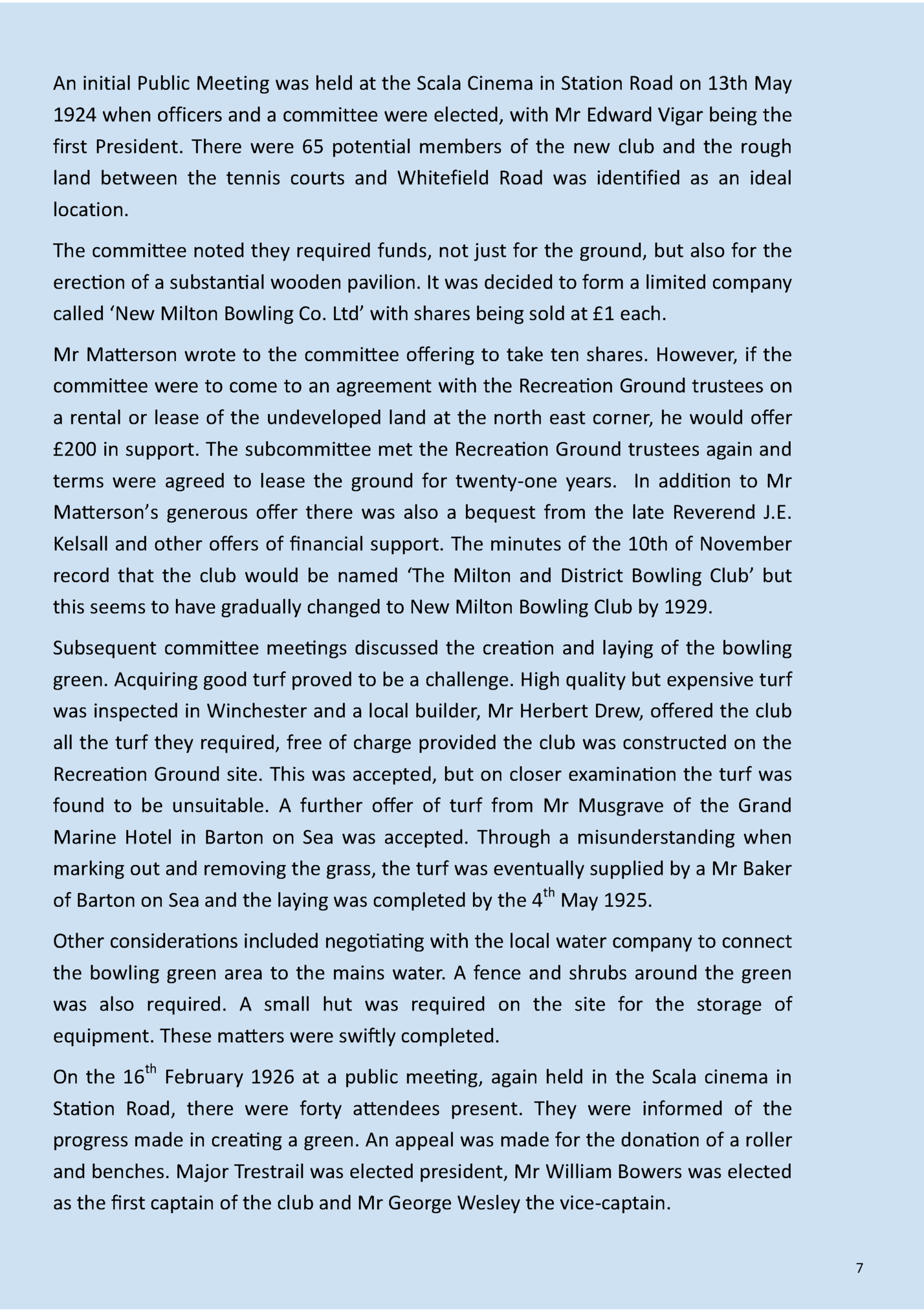
The opening day for the club was held on Tuesday the 28th of April 1926. The President, Major Trestrail welcomed the guests and thanked all those who had contributed to the creation of the club and a first-class green. The daughter of Mr J.K. Matterson formally opened the club and her brother Mr Matterson junior bowled the first wood. A match then took place between teams led by the captain and vice-captain took place. Fund raising for the new club was a problem in the early years. Whist drives and social functions helped to bring in much needed finance. At the first annual dinner, held in February 1927, it was announced that the club was in good shape. It was not in debt and had forty-four members. The president stated he wanted to raise that number to one hundred which would put the club on a much sounder financial footing through the subscriptions. 8
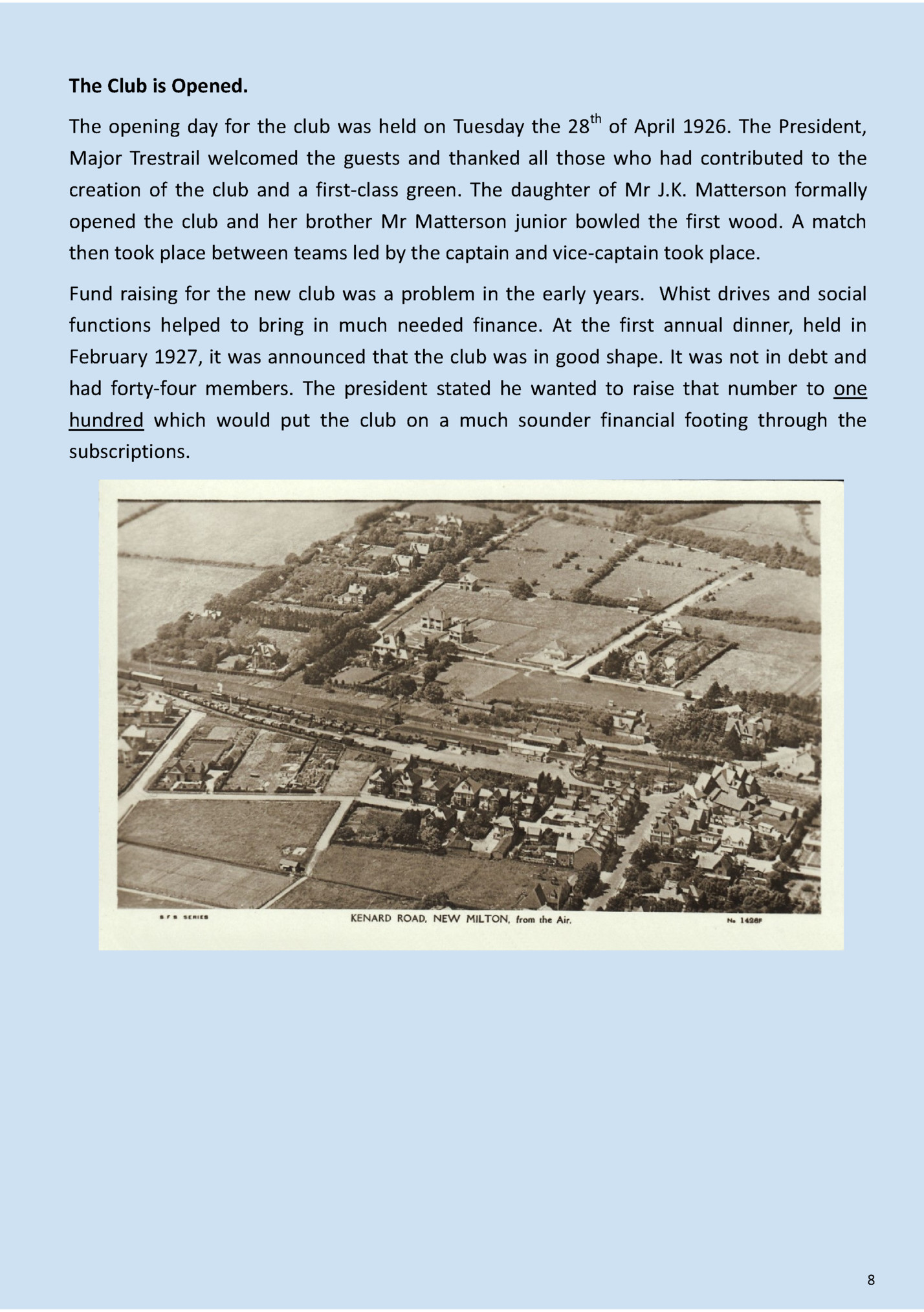
It was clear that the club needed a pavilion beside the green for players, visitors and spectators to use. Plans for a club house were drawn up by local architect Mr Hinton-Stewart and the minutes of 3rd of October 1928 records that six tenders from local builders were received. They ranged in cost from £177 to £241. At that me the fund-raising efforts for a club house had raised £60. It was agreed that a club house was necessary but something less expensive and ‘less preten ous’ was required. The commi ee inves gated the possibility of buying a small wooden bungalow in Barton on Sea, dismantling it, and moving it to the bowling green. This was considered to be imprac cal. The minutes of 31st of March 1929 record that commi ee member Captain Waggo said that he had studied the plans and believed that he could build the pavilion for £80 excluding the installa on of sanita on. The commi ee accepted this offer. The pavilion was to be sited in the south eastern corner of the bowling club grounds as this was the nearest point to mains water. The New Milton Adver ser published on 27th of April 1929 reported that the newly constructed pavilion for the club was big asset. It describes the building as being of ‘a decidedly a rac ve nature, having a large veranda, and forms a very pre y picture in the large area covered by various playing grounds.’ The report stated that Captain Waggo had undertaken the building of the pavilion and that the members of the club paid for the materials. Further costs arose for the pavilion when it was connected to mains water and the gas supply. These were again paid for by contribu ons from the club members. Compe ons and Affilia ons On Monday 26th of August 1929 eight players from the Hampshire Bowling Associa on came to the club for a match. Two of the team were English Interna onal players. The Hampshire team won by 31 shots to 28. The club were congratulated on their skilful play and the secretary of the Hampshire Bowling League encouraged them to enter the county league which would provide an opportunity to gain more bowling experience. 9
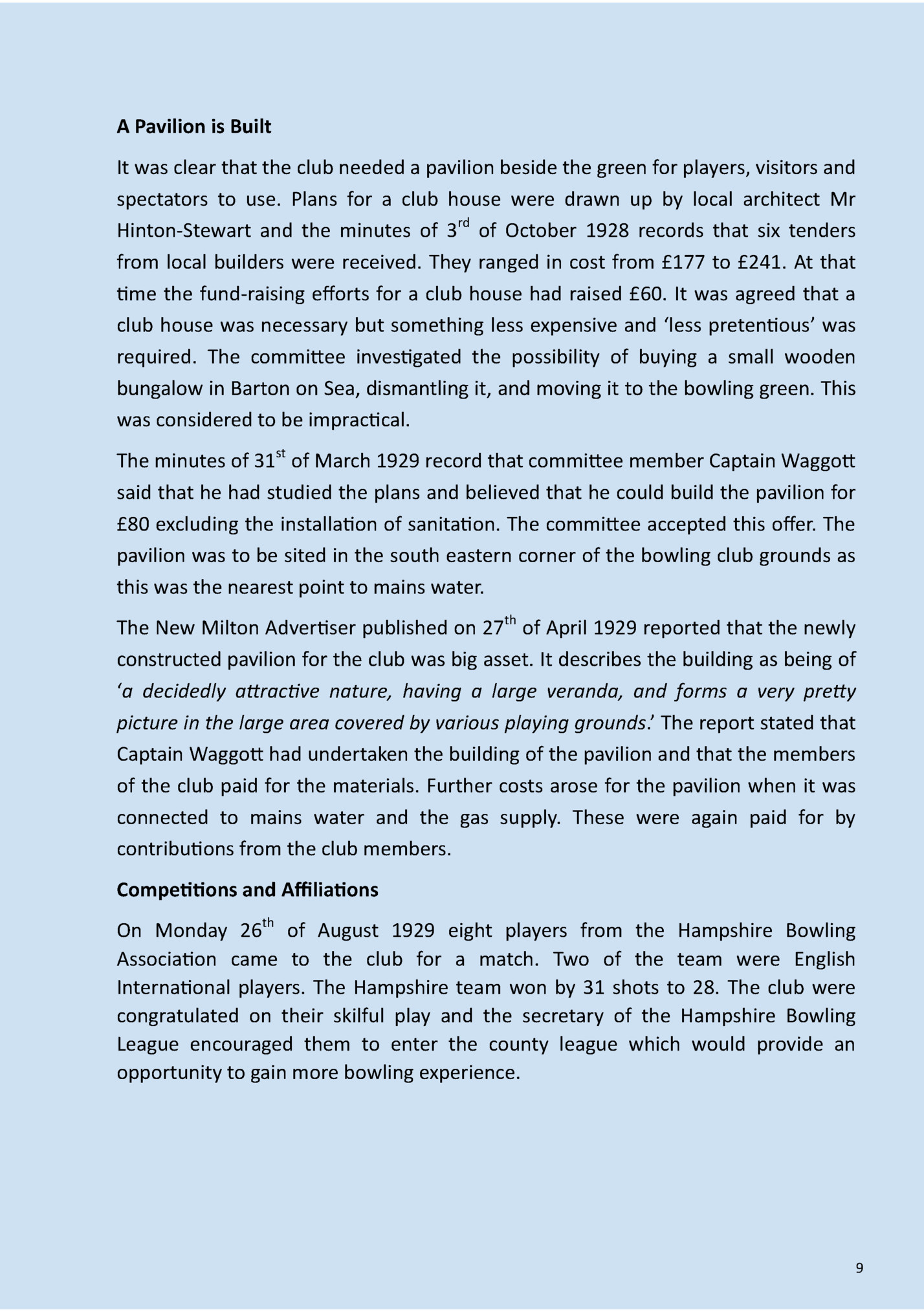
Fleepit Digital © 2021